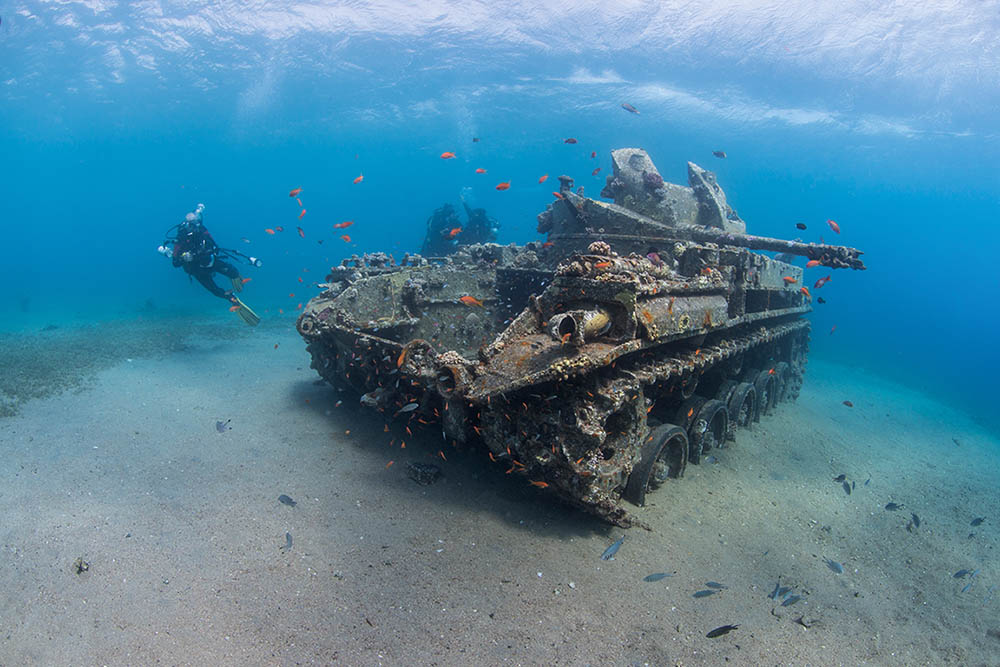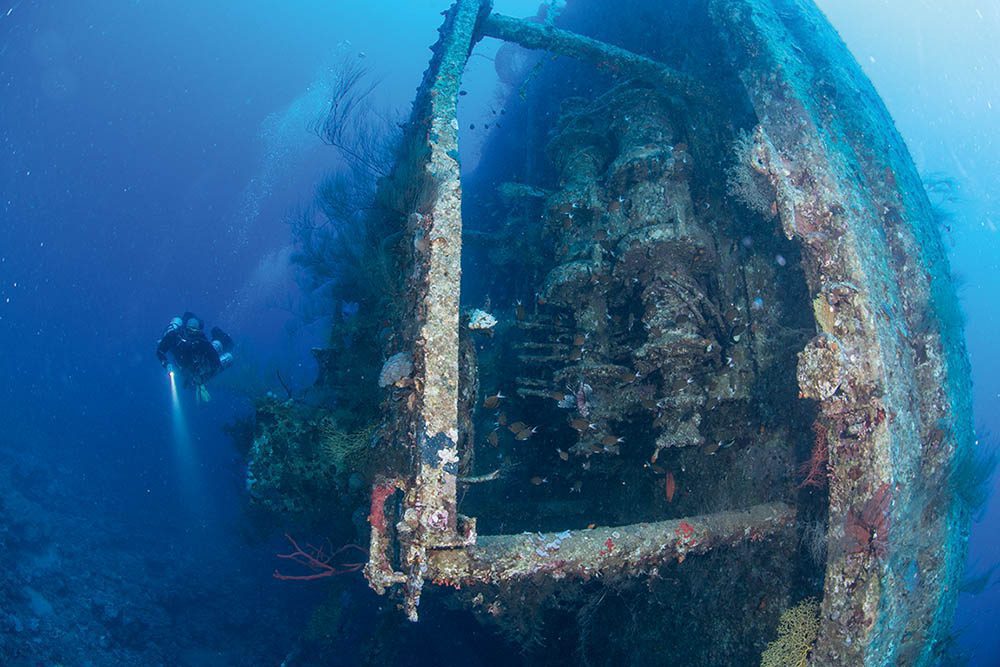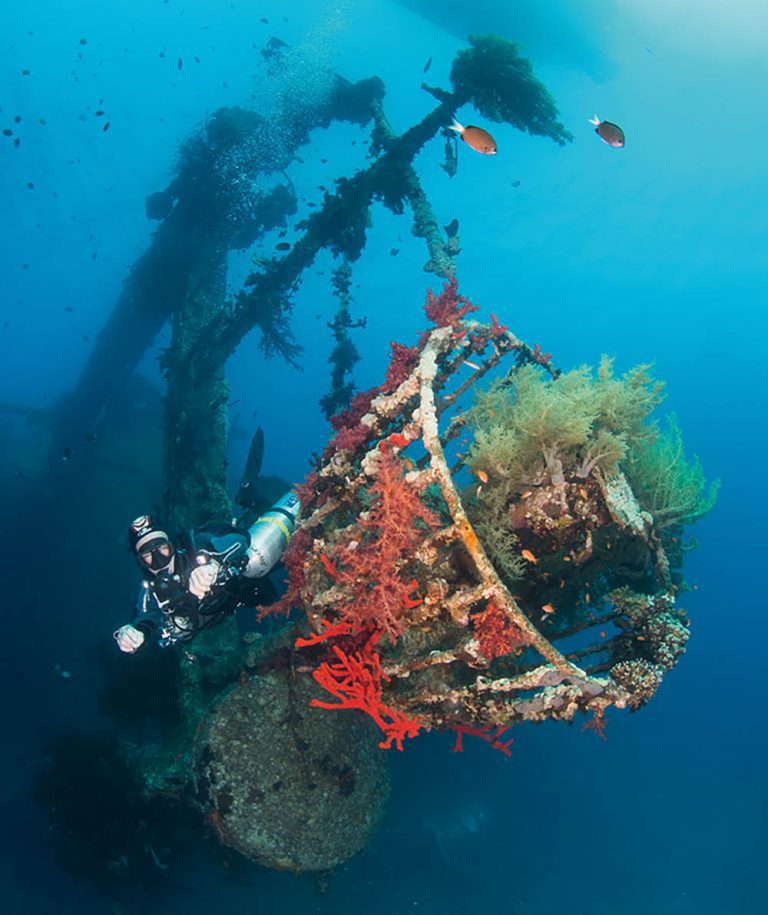JORDAN DIVER
We’ve heard a lot about Jordan’s attractions in conventional recreational depths, but what does Jordan’s stretch of Red Sea coastline have to offer technical divers? Deep diver DAN BURTON went to check it out, but had to agree that the famous Cedar Pride (pictured) is hard to beat
THE RED SEA
THE RED SEA CONTINUES to be one of the most spectacular diving destinations in the world, rich in underwater flora and fauna and home to an abundance of marine life. Its proximity to Middle East troubles has, however, left resorts quiet, with many hotels and dive-centres struggling.
Considered one of the most stable and safest of Middle East destinations, Jordan is a prosperous country on the east bank of the River Jordan, flanked by Israel and Palestine to the west and Saudi Arabia to the east, and with Syria and Iraq lying at its northern and north-eastern borders.
It is only at its south-western tip that it touches the Red Sea, spanning 17 miles of coastline on the Gulf of Aqaba.
Having enjoyed many Red Sea dive-trips, primarily to the Sinai, Hurghada and the southern Egyptian Red Sea sites, I was keen to check out recommendations to sample the diving at Aqaba in Jordan.
This ancient seaport is the largest and most populous city in the gulf, and has been a dive destination since the 1980s.
Despite the relatively short coastline, Jordan offers more than 25 dive-sites, but I was particularly keen to dive with some of Aqaba’s technical-diving centres and explore some of the deeper sites that are rarely mentioned in dispatches.
My journey started from London with an overnight stopover at the airport hotel in Jordan’s capital Amman. The following morning I boarded an early flight to Aqaba and was greeted by guide Mohammad from DeepBlue Dive Centre.
To get acclimatised to the deep sites we had planned later in the week, we made our first dive on the wreck most usually associated with Jordan, the Cedar Pride.
This 74m cargo ship sailed into Aqaba in 1982, and shortly after its arrival a large ballast fire damaged the inside of the ship beyond repair.
The vessel spent three years sitting on the quay before the government decided to sink it, and conducted a survey to find a suitable 30-40m-deep site.
The King of Jordan, a keen diver, took an interest in the event and it was decided to make the ship part of the reef. The wreckage proved to be an ideal habitat for the rich marine life living in this quiet area of the Red Sea.
WE MADE A SHORT JOURNEY to the local pier and kitted up on single 12s with nitrox 32. The site is situated in Aqaba Marine Park, just 30 minutes from the harbour. It’s a possible shore-dive, but the boat makes for a safer and more comfortable dive-platform and helps divers to avoid the glass-bottomed boats that regularly cruise the waters.
On arrival, we tied up to a buoy just 200m from the shoreline. We jumped in and descended the mooring line. After just 5m the stern came into view. My first impression of that stern was its similarity to the Giannis D in Egypt. Straight away I felt that this was going to be a good dive.

The visibility was 15-20m, so the stern section provided a perfect view for classic wide-angle shots. My dive-buddy Natalia made an ideal model, and swam into place just off the hull, where I took a few shots before we made our way aft to the main mast.
There was less fish life than I had hoped, but around the crow’s nest on the main mast the whole structure was covered in an array of soft corals swaying in the gentle currents.
There was plenty of superstructure on the site, so no shortage of opportunities to explore and swim up and down gangways and stairwells.
Natalia led me to the bow, and we spent time swimming among some of the large winches and masts.
After 40 minutes we made our way up the side of the hull and investigated the shallow section of the wreckage in just 8-10m, where we spent the last part of the dive.
THE FOLLOWING MORNING we moved on to Sindbad Dive Centre, just a few miles down the coast. The facility supplied us with a set of double 12s with 18/45 trimix (bottom mix), deco bottles of 50/50 nitrox and 80%.
After checking our mixes and kit, we strolled down to the pier just 100m away, where we were warmly greeted by the dive-boat crew.
Our plan was to dive the Al Shorouk, a cargo ship sitting in 38-58m at the bottom of Eel Canyon. The cargo vessel was scuttled in 2008 by Aqaba Marine Park
at a planned depth of 60m. As the ship started to sink she drifted offshore into deeper waters, and would have dropped to 100m had it not been for the frantic attempts of the crew to pull her back into shallower seas suitable for technical dives.
We loaded up and made the short journey to the dive-site, just 10 minutes from the dock. We dropped down the shotline through the gloom until the leaders reached the landing-craft door on the bow at 38m.
The wreck sits on its starboard side on a sloping reef that shelves down to 60m-plus. Our four-man dive-team split up, and I made my way along the edge of the cargo-hold with my buddy Khaled.
There was little to see other than a flat hull and an empty hold below us that was once filled with cars and trucks.
In the distance the bridge slowly appeared. I headed down the starboard side to 47m and Khaled moved over to the port side of the wreckage. He got into position and I ran a few shots of him exploring the stripped bridge.
We made our way under the bridge and swam along the guard-rails, where a line of luminescent pink soft corals covered the railings. The superstructure is in good condition, with small traces of paint still dotted over its bare hull.
Khaled signalled, so I followed him down a short stairwell to the barren aft deck. I could see some of the other divers’ torches flickering around the stern, so we made our way over and headed down to the prop at 58m.
We had clocked up 18 minutes, so it was time to head back to the shotline. Khaled took the high route along the top of the hull, and I decided to track over the bridge.
As I swam along the hull, the other half of the dive-team was shadowing me along the seabed. After a few minutes we got back to the bow and rejoined the others before making our way up the line to carry out our short deco.
This wreck is in a great location that allows you to visit other wrecks in the vicinity. It is possible to make a 20-minute swim from here up the reef to the Tank, which sits in just 8m on a sandy plateau.
It’s known as the Tank but is actually an M42 Duster, a self-propelled anti-aircraft cannon. The army vehicle was scuttled as an artificial reef in 1999
by the Jordanian Royal Ecological Diving Society and makes for a great little dive ideal for beginners, snorkellers and any photographer who enjoys something more unusual to shoot.
AFTER A COUPLE OF DAYS’ diving, and feeling well-settled, I was eager to explore, so our guide Nancy took us to downtown Aqaba. We spent three hours discovering the back-streets and markets, while taking in the eastern smell of fresh spices and the sticky Bedouin coffee that street-vendors kept bubbling away.
The group felt extremely safe and were never harassed by anyone trying to impose their wares on us.
We made our final deep dive the following morning on the Taiyong wreck. We joined up with Arab Divers, a traditional dive-facility situated down a dusty road a short distance from the beach. Our Brit guide Paul Rose (another one!) loaded our kit into a Land Rover trailer and we headed for the dock.

The Taiyong sits on its starboard side in 50m at a site called Japanese Gardens. Maximum depth is 57m, but the shallowest part is in just 35m.
The vessel was bought by the Aqaba port authority in 1974 and used for offloading incoming ships. Then an accident occurred – a crane’s jib dropped, damaging the hold.
With no proper engineer available, the resulting hole was repaired using an unsuitable concrete plug. This kept leaking, and with the vessel eventually deemed uneconomical to repair she was scuttled in 1999.
With no buoys immediately over the wreck, our boat tied off to another mooring a short distance away. We dropped to 12m, then headed down the sloping reef to 40m. At the bottom of the reef the hull slowly appeared, standing almost upright from the seabed.
Paul and I spent the first part of the dive investigating the superstructure and finning through the large pieces of machinery on the aft-deck.
One of the most spectacular parts of the wreck was the large double jib, protuding about 30m into the open seabed from the hull, which tilts inwards slightly.
This tendency I noticed only after looking at my images once surfacing, and it surely makes the wreck vulnerable to tipping over in the future!
We swam through the superstructure, where groups of lionfish hovered among the twisted wires and cables in wait for prey. Paul guided me through the labyrinth of metalwork and headed to the stern, where we investigated some of the giant winches.
We had a quick look from out on the reef and made a wide sweep out over the jib to get the big picture of the whole wreck structure, then slowly made our way back up the reef, where we did our stops on the reef under the boat.
OF ALL THE AQABA DIVE-SITES, the Cedar Pride came top for me, with the Taiyong coming second. Because I made only two short gas dives I didn’t get to explore the two deep wrecks as thoroughly as I would have liked, and I’d like to return to check both out again.
I did, however, get the chance to dive the Cedar Pride twice, and my reward was a satisfying collection of stills. The Pride is an all-time classic wreck dive that many people would be happy to dive over and over again.
Jordan isn’t normally thought of as a technical-diving destination, but it seems to me to have a lot to offer both in terms of wrecks and deep reefs.
I enjoyed being able to make a deep dive in the morning, come back for lunch at the hotel to meet up with my family and friends and then go out again in the afternoon.
There are plenty of places in and around Aqaba to interest all the family. If you decide to take a few days off, it’s well worth taking a day-trip to Wana Rami Reserve or the World Heritage site of Petra. I had the chance to visit both, and they were a highlight of my trip. The Dead Sea also makes for a popular side-trip (see Deep Breath, December).
Jordan isn’t cheap, and prices are comparable to the UK’s. If you plan to make a few trimix dives, be prepared to be charged about £220 for a trimix fill.
Can I bring a rebreather? you may be wondering. Well, they’ve been banned since 2014 – this is because of security issues at a location so close to Saudi Arabia and Israel.
All the facilities we visited cater for technical diving, with various levels of expertise. My advice is to ensure that you bring all the hardware you’re likely to need or check in advance that it’s available, or you might be disappointed.
There are scheduled flights to Amman daily, but be ready for a five-hour stopover to get a connecting flight to Aqaba. That sounds OK,
But factor £600 into your budget for the flights. EasyJet used to offer amazing deals but then stopped flying to Jordan. Encouraging news is that this flight might be starting up again.
Price might be a factor but Aqaba has much to offer, so spare a thought for this rich part of the Red Sea.
FACTFILE
GETTING THERE> Scheduled daily direct flights to Amman, with a lengthy stopover before the one-hour flight to Aqaba.
DIVING & ACCOMMODATION> Most dive facilities can arrange accommodation – Deep Blue Diving, Sindbad Diving, Arab Diving.
WHEN TO GO> Year-round. Best visibility is May- June. Water temperatures 21-28°C.
MONEY> Jordanian dinar. All dive centres and hotels take euros and sterling.
PRICES> Dive Worldwide has a “Getting Technical Jordan“ package for prospective tekkies, including flights and transfers, nine nights’ B&B and six dives plus one Discover Technical dive, from £1595pp, diveworldwide.com
VISITOR Information> Aqaba Website

